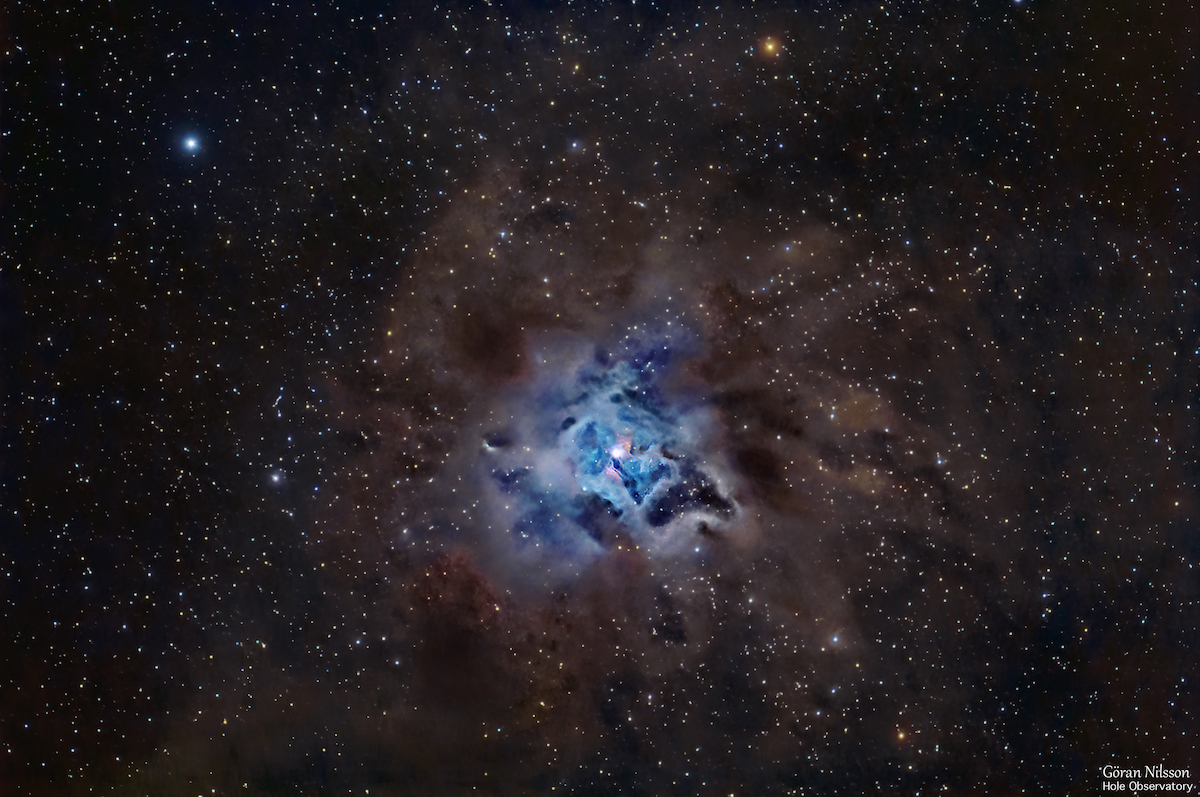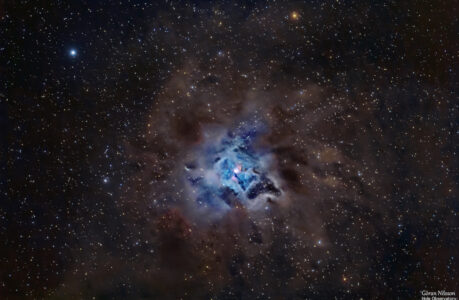First discovered by Sir William Herschel in 1794, the Iris Nebula derives its name from the Greek goddess of the rainbow, Iris. Located approximately 1,300 light-years from Earth, it is part of a larger cloud of gas and dust known as the Cepheus Molecular Cloud Complex. The nebula’s distinctive shape and vivid hues are the result of its composition: a combination of hydrogen, helium, carbon, and nitrogen.
To observe the Iris Nebula, a telescope with a moderate aperture is recommended. Its central star, HD 200775, is a magnitude 7.5 blue-white giant, and its light illuminates the surrounding gas and dust, giving the nebula its signature blue color. However, the nebula also contains regions of red, yellow, and brown, caused by the presence of organic compounds and dust grains.
For astrophotographers, capturing the beauty of the Iris Nebula can be a challenging but rewarding experience. Its intricate patterns and delicate colors require careful framing and exposure settings. Nevertheless, with the right equipment and technique, stunning images can be created that showcase the nebula’s full glory.
While the Iris Nebula is undoubtedly a sight to behold, it is not the only celestial wonder in the Cepheus constellation. Other notable objects include the Elephant’s Trunk Nebula and the Wizard Nebula, both of which are also reflection nebulae. For those with a passion for astronomy, exploring the wonders of Cepheus can provide a lifetime of discovery and inspiration.
The Iris Nebula is a stunning example of the beauty and complexity of our universe. Its vibrant colors and intricate patterns make it a popular target for stargazers and astrophotographers alike. Whether viewed through a telescope or captured on camera, the Iris Nebula is sure to leave a lasting impression on anyone who witnesses its cosmic splendor.
Cepheus Molecular Cloud Complex
The Cepheus Molecular Cloud Complex is a vast region of interstellar gas and dust located in the constellation Cepheus. It is one of the closest and most prominent star-forming regions in our galaxy and contains several notable objects, including the Iris Nebula, the Elephant’s Trunk Nebula, and the Wizard Nebula.
The complex is composed of several individual molecular clouds, each of which contains a vast number of stars and protostars. These clouds are primarily composed of hydrogen, with trace amounts of other elements such as carbon, nitrogen, and oxygen. The clouds also contain a significant amount of dust, which plays a crucial role in the formation of new stars.
Within the Cepheus Molecular Cloud Complex, star formation is ongoing, with young, hot stars illuminating the surrounding gas and dust. These newly formed stars are surrounded by protoplanetary disks, which may eventually coalesce into planets and other celestial bodies. The complex also contains numerous star clusters, including the young and massive NGC 7160 cluster.
The Cepheus Molecular Cloud Complex is an important area of study for astronomers and astrophysicists, as it provides a unique opportunity to observe the formation and evolution of stars and planetary systems. By studying the complex’s properties, such as its composition, temperature, and density, scientists can gain insights into the physical processes that govern the universe on a larger scale.
Finding the Iris Nebula
To find the Iris Nebula (NGC 7023), you will need a telescope and a star chart or planetarium software. The nebula is located in the constellation Cepheus, which is visible from most locations in the northern hemisphere.
To locate Cepheus, first locate the Big Dipper, which is part of the larger constellation Ursa Major. Follow the two stars that form the outer edge of the Big Dipper’s bowl, and they will lead you to the North Star. Cepheus is located just to the east of the North Star, and its distinctive shape resembles a pentagon or house.
Once you have located Cepheus, you can use a star chart or planetarium software to find the exact location of the Iris Nebula. It is located near the star designated HD 200775, which is the central star of the nebula.
When observing the Iris Nebula, it is recommended to use a moderate aperture telescope to capture its intricate details and colors. The nebula’s signature blue color is caused by the central star’s light illuminating the surrounding gas and dust. However, the nebula also contains regions of red, yellow, and brown, caused by the presence of organic compounds and dust grains.
In conclusion, finding the Iris Nebula requires a telescope and a star chart or planetarium software to locate the constellation Cepheus. Once you have located Cepheus, the Iris Nebula can be found near the star HD 200775. Observing the Iris Nebula with a telescope can provide a breathtaking glimpse into the beauty and complexity of our universe.

